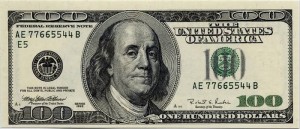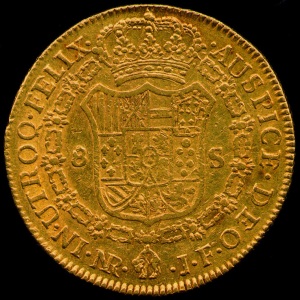Who supplies “money” has been an issue throughout history. The important difference in how the money supply changes in an economy using full weight coins as a media of exchange as compared to our modern system of fiat currency is that full weight coins were self regulated where as our modern fiat currency is regulated by the government.

Fiat Currency - $ 100 bill
With full weight coins the supply is not under the control of any single person but of individuals themselves. Since each person has control over this then they are most likely to mint coins if the price incentive is right. This is important because when there are lots of coins their value or price level is low, but, when there are few coins their value or price level rises. Full weight coins are intrinsically worth as much as they are extrinsically worth which means the supply of money cannot overreach the amount of gold or silver available to the person/nation. A person does not have the ability to spend money he or she does not have unless using some other means to attain goods; such as the barter system. Furthermore, when using full weight coins there is the problem of bimetallism. When there are two different metals which at different times can be worth more or less compared to one another: there is a problem. If gold is relatively scarce and worth more yet silver is abundant and worth a lot less then people are not going to demand as much silver which would make the supply drop. However this could lead to the problem of not enough small change. The lack of supply of silver could then cause other problems in the economy.

full weight spanish gold coin from 1700's
Fiat currency supply in modern times is under the control/regulation of the government. With governmental control of money, governments first must create a monopoly, which allows them to set the extrinsic worth of money. Friedman argues that if the government did not have a monopoly over the creation of money, too many people could enter the fiat money system which could potentially drive the fiat money down to its intrinsic value of 0. It is also argued that with governmental control of fiat money creates the ability for social savings as well as governmental revenues. Furthermore, governmental regulation of the supply of money can help a nation when in need. During the great depression the government pumped money into our nation. Although the government it’s self did not have that money, fiat money allows the government to spend money it does not have to help jumpstart an economy. Deficit financing has been an important part of history in helping to pay off wars in the past. Lastly, with government regulation of fiat money you know that if you have 1 penny that you have 1/100 of a dollar.
November 23, 2009 at 5:15 am |
This is so interesting. I knew the government regulated fiat currency but I didn’t know the extent or how it worked. I think that this is a great subject to touch on with the current economic times. I have never even heard of bimetallism. I am glad that I learn new things everytime I read your blogs!
December 11, 2009 at 11:42 pm |
Fiat currency has its advantages, but I think that unless there is something that has real value to back up government spending/minting/etc, we will always have a deficit problem. This has been shown in every economy that has used devalued currency since the Romans began mixing their gold coins with copper.